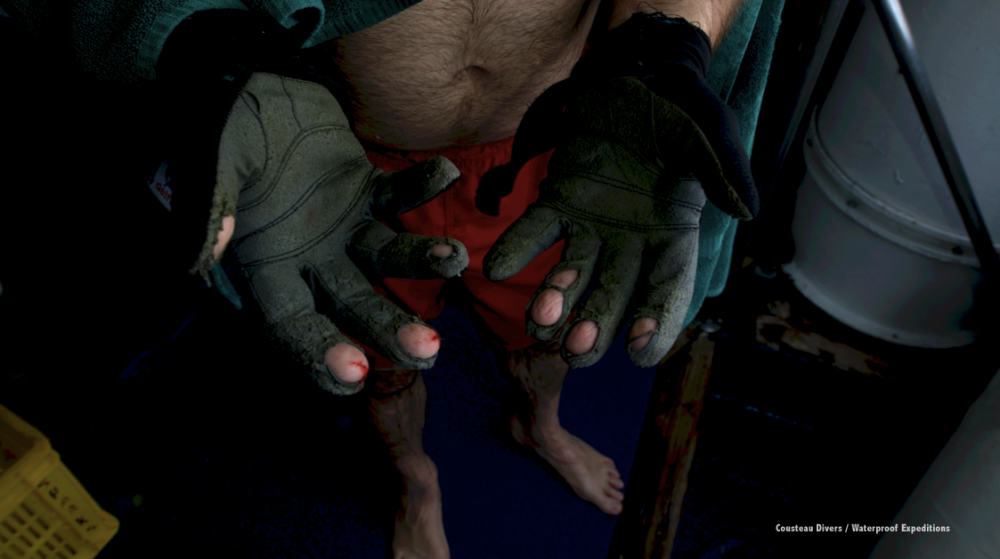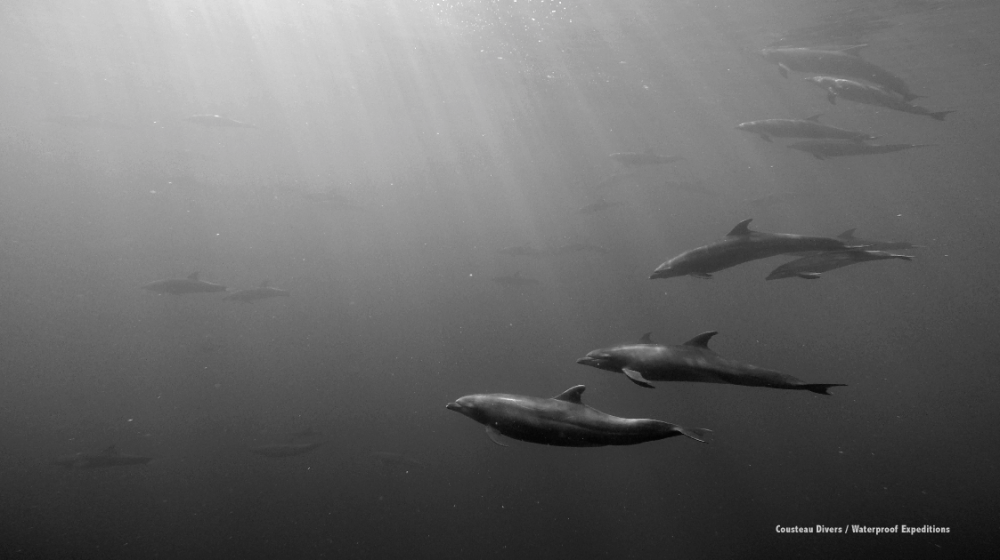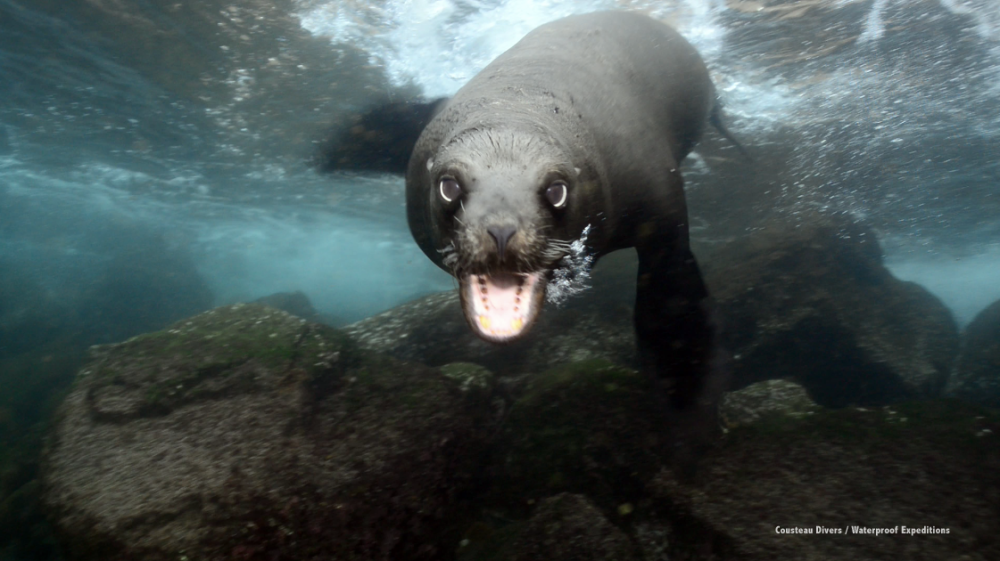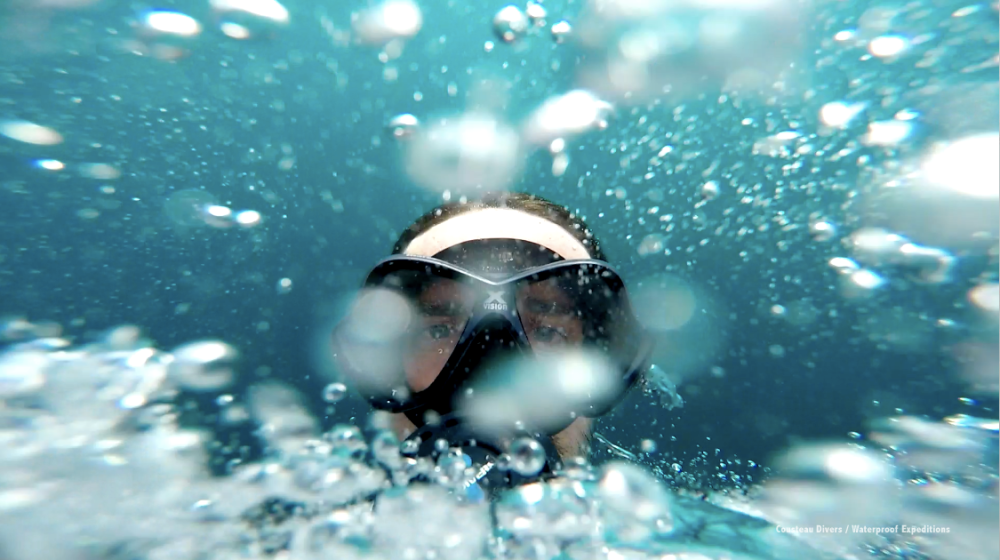Ocean, how I missed you.
Wild and free, alive. Still full of promise, mystery and surprise.
A blood moon rises as the Galapagos Sky sets sail to explore the coastal waters of the Galapagos Islands. A variety of passengers, both in nationality and profession, further adds to the rich diversity of the trip. A New-Zealand farmer, a British administrative employee, a Dutch software designer and tester couple, an Indian real-estate developer, a Swiss family, Steve and I… The crew, with their dedication and skill, are the essential ingredient that makes the trip successful. I notice with pleasure that the Galapagos Sky has been “tagged” by my friend Wyland with a beautiful hammerhead mural.

The diving conditions are exceptional. As in exception. Our guides have never had waters so warm, or currents so strong. In principle, neither is a good sign for observing marine life. As the water warms and the thermocline dives deeper, fish who prefer cooler waters stay out of sight. Strong currents mean we had to shoot images using one hand, the other one being busy holding on for dear life to a rock.

As we dive into another world, we become the invisible witnesses of millions of lives. We enter a universe we still know very little about. We fly among creatures without being able to hear their language. Territory, predation, cooperation, social behavior… We see only what is manifest, when countless unseen codes and gambits are played out in silence. Confused by our bubbly presence, the animals chose to ignore us. They are entirely absorbed in the necessities of every moment, and curiosity is a luxury that few can afford.
Around the islands of Wolf and Darwin, the exuberant dance of life is everywhere. We plunge into the ocean among hundreds of dolphins. Dense clouds of fish populate the blue, sprinkled with turtles, rays and eels. We hold onto rocks to fight the powerful (up to 8 knots!) current and out of the dark blue waters, hundreds of hammerhead sharks cruise by effortlessly. One of them shat on me. Some of them pause at cleaning stations where parasites are eaten and wounds are cleaned. A tacit agreement is passed between the apex predator and his grooms. In sheltered coves, sea lions play with rocks and marine iguanas feast on algae. It feels as though we have travelled through time.


Coming up from one dive Steve and I find ourselves a bit far from the rest of the group, after filming sharks. The sun is setting and the dingy is quite far away, collecting other divers. I am suddenly reminded of our status as strangers in this wilderness. Dangling at the surface above hundreds of sharks I think: we’re perfect prey! I immediately put on my mask and peer down into the thick, dark waters. Just at that moment, a silky shark bolts up from the deep to examine us. After a rapid assessment, it dives back down into the dark blue. Steve and I take turns looking down and hailing the dingy until they pick us up.

Returning to the Galapagos Sky I am struck by the presence of a dozen dead birds floating around us, their corpses apparently intact. Of the thousands of birds who constantly circle the Island of Darwin, I wonder if this is a natural “skimming” of the weak by competition or by disease. Our guide Jeff explains that these birds have starved or drowned because the thermocline is too deep, and the surface waters are too warm, meaning that the natural prey of these birds have dived deeper than they can reach. (Those familiar with my father’s movies will notice a certain physical resemblance between Jeff and Falco).

As part of Project Hermes, I’ve been diving with the Sensus Ultra, whose accuracy was tested in the Australian waters of Heron Island by the University of Queensland’s Global Change Institute team. Dive profiles were also recorded from our dive computers. The surface temperatures were a most comfortable and exceptionally warm 30 degrees Celsius on most dive sites, with often no thermocline down to 30 meter depth. Speaking with Jeff and Max our dive guides of the Galapagos Sky, they’ve never had surface waters so warm.
They bring my attention to a daily log that every dive operator in the Galapagos submits to the authorities. I am delighted to see it contains bottom temperatures, as measured by the guide’s dive computer. Sadly the values are not assigned to a given depth, and the guides assure me that as a rule of thumb, they are measured at 20 meters. With the large error margins of the dive computers and this new depth uncertainty, I doubt this data will be much help in assessing the effects of El Nino. However, I ask the captain for a copy of the logs and GPS coordinates of the dive sites for future analysis. It will be interesting to compare the Sensus’ data between the two trips, with a one-week interval. The 0.02 degree accuracy of the device will help reveal any significant change during that period. I will make a dedicated post about Project Hermes and how it is progressing. For some background information, check out this Nat Geo blog post. The divers were also given a Cousteau Divers Galapagos logbook, to note the presence of bio-indicator species and human impacts. Their observations will be collected and compared to the ones we made in 2012.

In 2016, you have to travel far in order to witness the miracles of nature in its untamed wilderness. As far as possible from the mega-cities and industrial sprawls. Far from the madness of men and women who constantly obsess about growth, greed and domination. How the underwater world has degraded since the days my father revealed it with his movies… Clearly the situation would be worse if he hadn’t, but also clearly his efforts were insufficient to prevent the decline entirely. Raising awareness can only go so far. For the next expedition to Tahiti with Waterproof Expeditions, in July 2017, I will spend more time searching the Cousteau archives in an attempt to produce before / after visuals as a testimony.

Climate change, habitat degradation, overfishing, plastic pollution… the list of our inconsiderate squandering of the ocean is long, and the Galapagos seem to have been successfully sheltered from these plagues so far. In fact I was delighted to note that I did not encounter a single piece of trash of any size during the week at sea: something I cannot say of any other place I have been in the world. Our guides explain that the National Park has very strict rules for disposal of trash in general and plastic in particular, with efficient collection mechanisms. However, I was saddened to learn that most of the plastic ends up in a landfill, here in the Galapagos. At least the collection is good. Recycling and disposal would be better. An absolute ban on single-use plastics, worldwide, but here in particular, seems necessary.

I’ve always wondered if there was a common cause for all this blind destruction. It seems to me that the reason is embedded in our minds: a lack of foresight and understanding of the real costs of our actions. What is referred to in business as “externalities”. I am convinced that sustainable development is possible, but it requires far more brainpower than is currently being used. More innovation, more research, and a shift in subsidies. So why don’t we turn our mind’s eye towards achieving it?

In a recent piece of work I did for IUCN, people were consulted across Europe to identify the main barriers to achieving sustainable development for the sea. Awareness and education came out on top as the most powerful ways to overcome those barriers. However, the social ecosystem itself appeared to be the main blockage in converting that awareness into action. The cultural values and cognitive frameworks that infuse our contemporary societies are diametrically opposite to the ones that would foster environmental stewardship. The obsessions with financial success and personal image prevent us from making the sustainable decision when given equivalent choices.
But how can you appeal to moral duty and self-transcendence when people are struggling to make ends meet, and constantly terrorized by the media into avid conformity? Social sciences are the missing piece of the puzzle for conservation and sustainable development to steer the Titanic of our civilization, and as the environment degrades, so do the options for living outside of the “rat race”. A vicious cycle. We must bring people into the equation of conserving natural resources by appealing to intrinsic values and calling for a transparent examination of the values that we are constantly being bombarded with, mostly by mainstream media and advertisement.

The information I had received prior to my previous blog post was true: the islands of Wolf and Darwin have been given no-take status by the president of Ecuador. This is fantastic news for marine life in these exceptional sites. But it seems the people, the few local fishermen who have always practiced small-scale traditional fishing in that area, were not considered in this process. They demand some kind of compensation, or right to fish in a reduced area between the two islands. In such a remote place, where daily enforcement is practically impossible, it would seem wise to at least consult, if not actively engage the fishermen in the establishment of the protected area. Once again, social sciences have been left aside, and the consequences for the success of the protection remain to be seen. I have interviewed the mayor of San Cristobal and the local fishermen during my time here and will give more detail on this in the next post.

All the images you see here are screenshots from the videos I have been filming. The Big Blue lights have proven to be amazing and incredibly durable. I have not yet managed to cycle through the battery entirely, even by leaving them turned on for two consecutive dives. Next week I will try to shoot some good stills, but I’ve been having some technical problems with my strobes. They fire optically and the housing I have for the camera has an in-built electrical system, which I had no time to replace before the trip. So I use an electrical to optical converter, and that has proven to be a nightmare… firing rather randomly. I plan on piecing together the videos into a mini-documentary for the web, featuring some of Steve’s exceptional high-speed footage. Stay tuned.
~ Pierre-Yves Cousteau
www.waterproof-expeditions.com


I once heard that top environmental problems are not biodiversity loss, ecosystem collapse and climate change – the top environmental problems are selfishness, greed and apathy. These three things natural science for sure can’t solve. That’s why we need a spiritual and cultural transformation and I really hope that social science can be part of it.
Thank you for a very nice and inspiring post! Wish you amazing dives next week 🙂
LikeLiked by 1 person
Great post Pierre-Yves. Congrats, keep up the good work!!!!!
(even if sharks shit on you)
LikeLiked by 1 person
Great post! I used to work with the local artesanal fishers in the Galapagos back in 2012. It is very disappointing to hear that one of the most important stakeholders from the decision making of the new marine sanctuary has been left behind. Fishers there know their resources and their opinions really matter. I believe in a participative co-management of the use of natural resources, is the key for success. Looking forward for your next post.
Ps: If you need any Ecuadorian on your crew let me know 🙂
LikeLiked by 2 people
I wonder if the change around the islands are due to the warmer water caused by the radiation from the destruction of the nuclear power plant Japan. The warm waters have effected the coral in northern Australia and a lot of damage on the west coast of America. Just food for thought
LikeLiked by 1 person
Going to Galapagos in 2017. Thanks for the great pictures!
LikeLiked by 1 person
When i was a little girl i was completly fan about the Calypso adventures, but did not understand that the purpose was to protect seas and oceans! Now i am a big girl and i’m following your action, and i am proud of your family and the way you take action! Hope one day you will come visit New Caledonia! And if you come, contact me! (i aman ambassador for kanak people)
LikeLiked by 1 person
Thank you Veronique! I will actually be there this summer, so let’s definitely connect.
LikeLike
Super ! Thanks for sharing Pierre-Yves !
LikeLiked by 1 person
Good evolution in thought. Thank you for sharing!
If the sustainable development passes through the hierarchy of needs, one need not remain on the level of moral duty, Esteem or Self-transcendence, but provide humanity with a potential solution for guaranteeing its personal and economic safety. We may thus be able to see where the human motivation for sustainable development lies.
Growth, greed and domination seem to provide an easy way of guaranteeing physiological safety in current individualistic societies. However, with new job opportunities and more competitive productivity in the international market, investment in sustainable development today offers an opportunity for the younger generation to create a more balanced life. Not everyone loves the ocean but surely most people love their children.
How IT specialists at IBM laughed at Bill Gates and Steve Jobs’s notion that personal computers could transform the world: no one had any idea how that development would so profoundly impact on the world in terms of business, education, medicine etc. Van Gogh said, “Je n’ai pas l’intention de m’ennuyer même si notre époque est fade ». So even if a barrel of oil in our time costs 33 dollars, something can surely be done. Looking forward to your next post!
LikeLiked by 1 person
Thanks for your insights Nicolas!
LikeLike
Tahiti 2017 !!! cool!!!!
LikeLiked by 1 person
Very interesting post, but it is really hard on the eyes!! The font is really difficult to see. Any chance of making it more readable next time? Hopefully we can also have more discussion of the social science side in future posts.
LikeLiked by 1 person
This is great! Thank you for sharing.
I look forward to the next update.
LikeLiked by 1 person